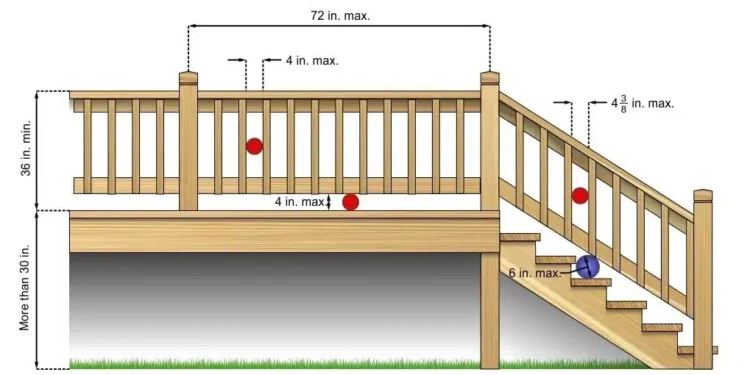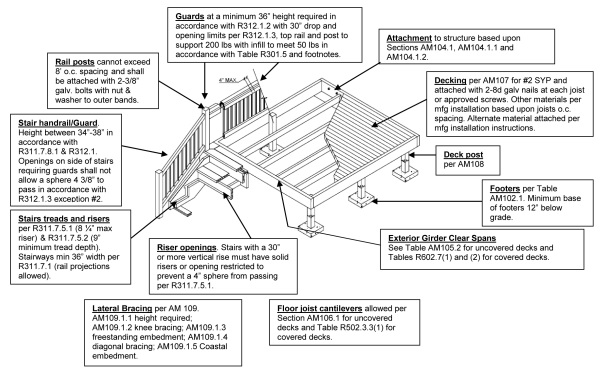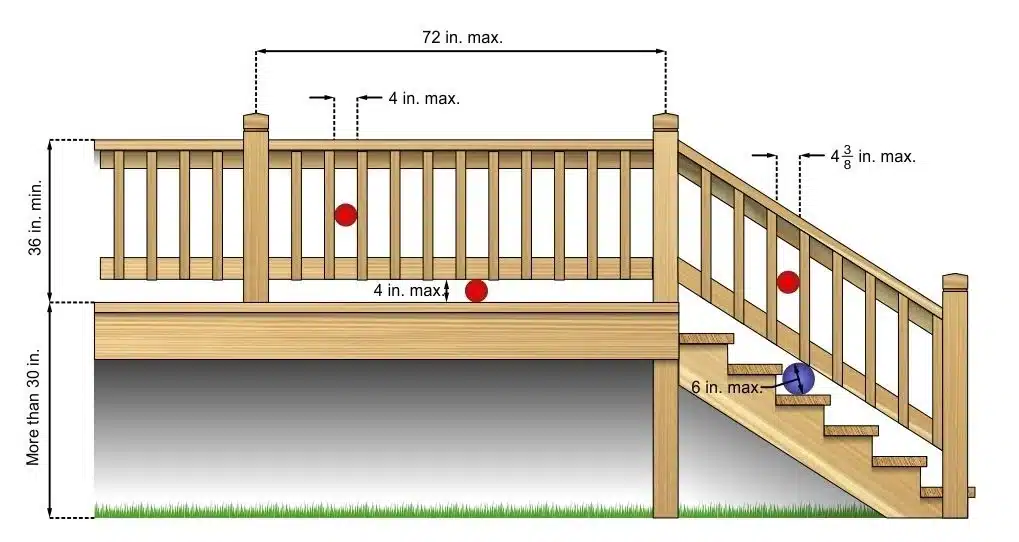Deck Building Codes

Most homeowners don’t realize that deck footings must go at least 36 inches deep when attached to a structure. Standard residential deck railings need to be thirty-six inches high, though some areas might ask for different measurements. You might be surprised to learn that builders can secure posts into the framing in at least nineteen different ways.
Local building regulations play a crucial role in deck projects. To cite an instance, you’ll need a building permit if your deck stands 30 inches or more above grade or comes with an attached roof. On top of that, you must space your joists correctly – wood decking needs them 16 inches apart to stay stable. Each state follows its own deck building code. North Carolina, Wisconsin, Ohio, and Florida all have unique requirements. So homeowners should check their local rules to see if they need a permit.
This piece covers the deck building codes and requirements that people often miss. Everything in deck building guidelines matters – from setting footings below the frost line to picking the right post size (usually 4″ by 6″ or 6″ by 6″ in places like California). These rules help keep your deck safe and compliant.

Table of Contents
- 1 Do You Need a Permit to Build a Deck?
- 2 Footings, Posts, and Beams: The Structural Foundation
- 3 Deck Joists and Ledger Boards: Common Missteps
- 4 Stairs, Railings, and Guardrails: Safety Code Essentials
- 5 Top Mistakes Homeowners Make with Deck Building Codes
- 6 Summing all up
- 7 Here are some FAQs about deck building codes:
- 7.1 What is the 3 4 5 rule for deck building?
- 7.2 What is the largest deck without a permit?
- 7.3 Do I need building regulations for decking?
- 7.4 How high does a deck need to be off the ground?
- 7.5 What is the 6 8 10 square rule for a deck?
- 7.6 How far apart do you need footings for a deck?
- 7.7 Can I build my own deck?
Do You Need a Permit to Build a Deck?
Many homeowners think building a small deck is just a weekend project that needs no official oversight. But knowing permit requirements is vital before buying any materials. The right approach to deck building codes can help you avoid thousands in fines and serious safety risks.
At the time a deck permit is required
We needed deck permits for structures that exceed 30 inches in height from adjacent grade to the walking surface. This height limit exists because taller decks create bigger structural and safety risks. All but one of these decks attached to homes (ledger-framed decks) need permits no matter their size.
You need permits not just for new builds but also to replace decking, rails, and stairs on existing structures. Local building departments often treat decks, porches, and patios differently. Some cities want permits for all three outdoor spaces.
Michigan’s building rules say you need a permit if a structure’s use changes. This means adding a deck that works as a new entrance needs official approval. Local rules often trump state guidelines, so check with your building department first.
Permit exemptions and misconceptions
Some decks might qualify for permit exemptions despite widespread rules. Here’s what usually gets exempted:
- Freestanding decks (not touching the house) under 200 square feet and less than 30 inches high
- Ground-level structures called “patios” instead of decks
- Decks not used as required exits
People often think small decks don’t need permits. The truth is, if it touches your house, size rarely matters. On top of that, while building permits might not be needed, you could still need zoning permits based on where you put the deck.
States like North Carolina, Wisconsin, Ohio, and Florida let local areas change the International Residential Code (IRC). This creates different rules even between nearby towns. What worked at your old house might not fly at your new one.
What happens if you skip the permit
Ignoring permit rules brings serious problems beyond just fines. Cities can stop your work right away with a “Stop Work” order. Fines often cost way more than permits – up to $5,000 per violation or $500 each day you don’t fix it.
Skipping permits leads to more headaches:
Your home insurance might not cover you. Insurance companies won’t pay for accidents on unauthorized structures. Selling becomes a nightmare too since buyers’ banks often reject loans for houses with unauthorized additions.
The worst case? You might have to tear it all down. If inspectors find an unpermitted deck breaks safety codes, they can make you remove it no matter how well it’s built. Problems that permit inspections could catch might cause accidents, leaving you on the hook for injuries.
Getting permits isn’t just red tape – it protects everyone involved. The time and money spent on proper permits is nowhere near what you might lose by skipping this vital step.
Footings, Posts, and Beams: The Structural Foundation
A deck’s strength depends on its foundation components. Beautiful deck designs can fail when footings crack, posts rot, or beams sag. Your outdoor space needs these critical elements to stay safe and meet code requirements for decades.
Minimum footing depth and frost line rules
Frost heave poses the biggest threat to deck stability. This powerful force lifts footings that weigh thousands of pounds and damages your deck’s structure. Your footings must extend below the local frost line, which changes based on your region.
Warmer southern states like Florida need frost lines just 12 inches deep. Northern regions near the Canadian border need footings up to 96 inches (8 feet) deep. The frost line shows how deep groundwater in soil might freeze during winter.
Building officials want footings that:
- Go at least 12 inches below undisturbed soil
- Extend below the local frost line, not just to it
- Rest on solid ground that supports concentrated loads
- Have at least 1,500 psf bearing capacity (soil tests needed if lower capacity seems likely)
Your footings must match the house foundation’s elevation if they’re closer than 5 feet to it. This stops uneven settling that could damage both structures. Going 3-4 inches below the minimum frost depth gives extra protection against rare extreme cold.
Post sizing and spacing requirements
Posts move deck loads to footings and need proper sizing. Building codes state that:
Deck posts must be 6×6 nominal or larger with a maximum height of 14 feet to the beam underside. In spite of that, some regions differ—California often needs taller railings (42 inches) with posts no more than 6 feet apart.
Posts need specific installation steps. They must sit centered on footings and connect to beams with approved hardware. Cut ends need field treatment with approved preservatives like copper naphthenate to stop rot. Through-bolts need washers under both the bolt head and nut to spread loads properly.
Posts usually sit 4 to 6 feet apart. These distances change based on beam sizes and spans. Taller decks often need closer post spacing to stay stable and safe.
Beam span limits and support rules
Beam spans affect your deck’s overall strength. The 2015 International Residential Code made beam sizing easier with Section R507.6’s complete span tables.
Joist spans, lumber species, and beam composition determine maximum beam spans. A double 2×8 beam using Southern Pine spans 8’6″ with 6-foot joists but only 7’4″ with 8-foot joists. Deck beams that support joists with 40 psf live loads must follow strict span limits.
Beams must:
- Connect to supporting members to prevent sideways movement
- Have ends rest at least 1.5″ on wood/metal or 3″ on concrete/masonry
- Splice over interior posts for multi-span beams
- Extend past end posts up to one-quarter of the beam span between posts
Built-up beams shouldn’t have joists framing from opposite sides. Attaching beams to post sides without notching isn’t allowed.
National codes offer general guidelines, but local rules often differ. Check with your building department about specific rules for footings, posts, and beams before starting construction.
Deck Joists and Ledger Boards: Common Missteps
The right installation of joists and ledger boards are the foundations of deck construction. These elements cause most structural failures across the country. Even DIY veterans often misread these deck building codes, which leads to costly and dangerous mistakes.
Joist spacing for wood vs composite decking
Your decking material determines the joist spacing requirements. All but one of these composite decking brands – Trex, AZEK, TimberTech, and Fiberon – need 16″ on-center spacing for straight installations and 12″ on-center for diagonal patterns at 45-degree angles. Regular softwood decking works well with 16″ spacing, and thicker hardwoods might allow wider spans.
The wrong specifications can create noticeable issues. Composite boards will start to sag over time if floor joists are too far apart. Yes, it is true that manufacturers have tightened their spacing requirements. Many towns that once allowed 16″ OC for composites now require 12″ OC.
Closer spacing doesn’t always mean better deck quality. Joists placed too close together make it hard to attach supporting elements like joist hangers, blocking, and flashing. You need to find the sweet spot based on your decking material.
Cantilever limits and joist hangers
The American Wood Council states that cantilevers – parts of joists extending past support beams – must follow strict rules. They can’t extend beyond 1/4 of the total joist span. Many building departments limit cantilevers to 24 inches max, whatever the joist size.
You can’t overlook joist hangers. These mechanical connections need a depth of at least 60% of the ledger’s depth. The hangers must be exterior grade and safe to use with newer treated lumber that contains more copper. Poor quality hangers will break down faster when rainwater meets preservatives.
The core team should avoid these common joist connection mistakes:
- Using clip angles or non-bearing brackets to support joists
- Gaps bigger than 1/8″ between joists and ledgers
- Wrong fasteners for hanger installation
Ledger board attachment and flashing errors
Ledger board failures cause most deck collapses nationwide. Since 2001, data shows that decks usually collapse because of nail-only connections between decks and main structures. The International Residential Code doesn’t allow using nails that can pull out as the only attachment method.
The ledger boards must connect to the house’s band joist with 1/2″ lag screws or bolts with washers. These fasteners should go through both the ledger and band joist completely. Through-bolts work best because the ledger can only detach if it pulls the internal structural parts with it.
Good fastening needs proper flashing to protect against moisture. The right flashing creates a barrier that keeps water from getting into the house through the ledger board connection. This system needs back flashing (behind the ledger), top flashing (above the ledger), and often bottom flashing to direct water away from the structure.
Stairs, Railings, and Guardrails: Safety Code Essentials
Safety issues with deck elements often lead to building code violations that can weaken the structure. We focused on three essential parts—stairs, railings, and guardrails. These components need specific requirements to keep everyone safe and meet code standards.
Deck stairs code: riser height and tread depth
Deck stairs need exact measurements. The riser height should stay between 4 and 7¾ inches. The tread depth must be at least 10 inches. The difference between the tallest and shortest riser in a flight should not be more than ⅜ inch.
Stairs should be at least 36 inches wide. A width of 48 inches makes it easier for people to pass each other. Open risers that are more than 30 inches above ground level must block a 4-inch sphere from passing through. This safety feature protects children from falling through the gaps.
Handrail height and graspability
Stairs with four or more risers must have handrails. The rails should be 34-38 inches high when measured straight up from the stair nosings. The right grip size matters for safety—circular handrails need diameters between 1¼ and 2 inches.
Handrails next to walls need a 1½ inch space behind them. This gap lets people grip the rail without hitting their fingers on the wall. The code approves two types of graspable designs: Type I (circular) and Type II (with finger recesses).
Guardrail height and baluster spacing
Decks more than 30 inches above ground need guardrails. Home deck guardrails must be at least 36 inches high from the deck surface to the top rail. Multi-family building decks need taller 42-inch guardrails.
The International Residential Code (IRC) lists these guardrail requirements:
- Balusters must have gaps smaller than 4 inches
- The space between the deck and bottom rail must be under 4 inches
- The triangle formed by stair treads, risers, and bottom rail must block a 6-inch sphere
- The top rail must handle a 200-pound force at any point
The right baluster spacing usually needs three balusters per foot of railing. Manufactured railings work best with posts no more than 8 feet apart.

Top Mistakes Homeowners Make with Deck Building Codes
Building inspectors nationwide spot the same deck construction violations time and again. Homeowners can avoid dangerous situations and projects that get pricey by learning about these common problems.
Using untreated or non-rated materials
Wrong lumber choices lead to most building code violations. IRC Section 319 demands protection against decay for all structural elements exposed to weather. You must use preservative-treated lumber suited to your needs. Posts that touch soil need ground-contact rated lumber (UC4A), while above-ground rated lumber (UC3B) works for other parts. Decks built with standard-grade lumber or misused above-ground materials often fail inspection. Older decks pose extra risks, since builders before the 1980s used wood without proper bug-fighting treatments.
Ignoring local code variations
Local building authorities often modify standard guidelines based on regional risks. Many homeowners check general resources without knowing that city rules override them. California’s deck projects face some of the toughest construction standards in the country. Builders who follow only state rules run into problems when these don’t match city codes. Smart homeowners check with local building departments before starting construction to avoid expensive fixes and delays.
Improper fasteners and hardware
Building inspectors report that wrong fastener choice tops their list of deck code violations. Every piece of structural hardware needs hot-dipped galvanized steel at minimum. Treated lumber requires G-185 galvanized or polymer-coated steel fasteners. Many homeowners mix incompatible metals, which creates galvanic reactions and speeds up rust. Joists often get attached with just screws or nails instead of proper joist hangers – another frequent violation. Ledger boards need lag bolts, not screws or nails.
Skipping inspections or final approvals
Skipping permits and inspections creates major risks. Building permits help ensure deck safety and keep homeowner’s insurance valid. Homeowners might face legal trouble if someone gets hurt on an unpermitted deck. Home sales often hit snags when buyers want proof of proper deck construction. The inspection process catches critical safety issues early – that’s crucial since decks cause more injuries and deaths than any other part of home structures. Failed inspections come with correction notices that spell out needed fixes.
Summing all up
Building a deck looks simple on paper, but many homeowners miss key code requirements that keep the structure safe. The permit process protects you from fines, insurance problems, and safety risks. A safe outdoor space needs proper structural elements. You must have footings below the frost line, the right size posts, and beams with correct spans.
Most deck failures happen because of wrong joist spacing and poor ledger board attachment. People don’t know the different rules for wood versus composite decking. Many fail to secure ledger boards with the right fasteners and flashing.
Safety features like stairs, railings, and guardrails need specific measurements to prevent accidents. Smart design includes the right riser height, tread depth, easy-to-grip handrails, and proper baluster spacing to save lives.
Local building codes are more important than general guidelines. You should check with your city’s building department before you start work. On top of that, it takes the right treated materials and fasteners to make your deck last through weather and time.
Some homeowners see building permits as just red tape, but this process protects current and future owners. Good permits, quality materials, and following codes cost less than what it all means if you take shortcuts. Taking time to follow deck building codes will give a beautiful, safe outdoor space that boosts your home’s value for years.
Here are some FAQs about deck building codes:
What is the 3 4 5 rule for deck building?
The 3-4-5 rule is a fundamental method for ensuring your deck frame is perfectly square during construction. This technique, referenced in deck building codes nationwide, involves measuring 3 feet along one side, 4 feet along the perpendicular side, and confirming the diagonal distance is exactly 5 feet. Whether following North Carolina deck building codes or Florida deck building codes, this principle remains consistent for proper deck alignment.
What is the largest deck without a permit?
Permit requirements vary by location, with most areas allowing decks under 30-36 inches tall and 120-200 square feet without permits. Wisconsin deck building codes may differ from Ohio deck building codes in exact dimensions, so always check local regulations. Even when exempt from permits, your deck must still comply with all relevant deck building codes for safety.
Do I need building regulations for decking?
Yes, all deck construction must adhere to local deck building codes regardless of whether a permit is required. Florida deck building codes, for example, have specific requirements for hurricane resistance that differ from North Carolina deck building codes. These regulations cover structural integrity, railing height, stair construction, and proper footings.
How high does a deck need to be off the ground?
Deck height requirements vary, but most deck building codes require railings for decks more than 30 inches above grade. Wisconsin deck building codes and Ohio deck building codes typically follow this standard, though some areas may differ slightly. The space beneath must allow for proper ventilation and meet local frost depth requirements for footings.
What is the 6 8 10 square rule for a deck?
The 6-8-10 rule is an expanded version of the 3-4-5 method for larger decks, ensuring perfect right angles in deck construction. This technique, recognized in all deck building codes including North Carolina deck building codes, uses multiples (6 feet, 8 feet, 10 feet) for more accurate squaring on bigger projects. It’s especially useful when laying out foundations for larger decks under Florida deck building codes or other regional standards.
How far apart do you need footings for a deck?
Footing spacing depends on deck size and load, typically ranging 6-8 feet apart under most deck building codes. Wisconsin deck building codes may require closer spacing in northern climates due to frost depths, while Ohio deck building codes might allow slightly wider spacing. Always consult local deck building codes as requirements vary based on soil conditions and expected loads.
Can I build my own deck?
Yes, homeowners can typically build their own decks if they comply with all local deck building codes and obtain necessary permits. However, complex designs under North Carolina deck building codes or Florida deck building codes might require professional engineering. Even DIY decks must pass inspections and meet all safety requirements in your area’s specific deck building codes.






